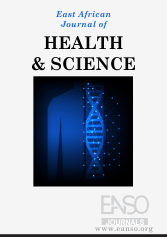Adverse Birth Outcomes in Kenya: Prevalence and Key Health-Related Predictive Factors- A Cross-Sectional Analysis of KDHS 2022 Data
Abstract
Background: Adverse birth outcomes (ABOs) including low birth weight, stillbirths, and early neonatal deaths remain a major public health concern in Kenya, contributing significantly to maternal and child morbidity and mortality. This study aimed to assess the prevalence and health-related predictors of ABOs using data from the 2022 Kenya Demographic and Health Survey (KDHS). Methods: A cross-sectional analysis was conducted using data from 17476 women aged 15–49 who had given birth in the five years preceding the survey. Adverse Birth Outcomes were defined as any occurrence of low birth weight, stillbirth, or early neonatal death. Statistical analyses included descriptive, bivariate, and multivariable binary logistic regression using SPSS version 28, accounting for sampling weights and survey design. Adjusted odds ratios (AORs) with 95% confidence intervals (CIs) were used to identify significant predictors. Results: The prevalence of Adverse Birth Outcomes was 11.1% which was contributed by 8% of preterm babies, 2.3% Low Birth Weight and 2.0% Neonatal Births. The key health-related factors that predict Adverse Birth Outcomes included number of ANC visits {with higher odds to those who scheduled ANC visits(≥8) (AOR = 2.947; 95% CI: 1.734–5.006), compared to women who had less than three visits}, timing of the first ANC visits {delaying the first ANC visit until after the first trimester resulted in lower odds of Adverse Birth Outcomes (ABOs) – AOR: 0.673; 95% CI: 0.412–0.729}, and parity/birth order{Multiparity exerted a protective effect among multiparous women showing decreased odds of adverse outcomes compared with primiparous women-AOR = 0.507; 95% CI: 0.461–0.559}. Conclusions: Adverse Birth Outcomes of over 10% of the population in Kenya remain a significant concern. Among the health-related factors that predict Adverse Birth Outcomes are the frequency of ANC visits (a paradoxical finding that demonstates that ANC visits frequency is significantly associated with higher ABOs), the timing of initiation of ANC visits and parity, which should be the focus of implementing targeted interventions to improve birth outcomes
Downloads
References
Ajayi, K. V., Bolarinwa, O., Adekunle, T. E., Alawode, O. A., Siuluta, N., Shongwe, S., & McCallum, E. (2025). Prevalence and determinants of preterm birth among women of reproductive age in Kenya: A multilevel analysis of the 2022 Demographic Health Survey. Therapeutic Advances in Reproductive Health, 19, 26334941251327181. https://doi.org/10.1177/26334941251327181
Alemu, S. M., Weitkamp, G., Tura, A. K., Wong, K. L., Stekelenburg, J., & Biesma, R. (2025). Maternal and perinatal mortality: Geospatial analysis of inequality in pregnancy related and perinatal mortality in Ethiopia. Health Policy and Planning, 40(3), 358–367. https://doi.org/10.1093/heapol/czae122
Blanc, A. K., & Wardlaw, T. (2005). Monitoring low birth weight: An evaluation of international estimates and an updated estimation procedure. Bulletin of the World Health Organization, 83(3), 178–185.
Blencowe, H., Cousens, S., Jassir, F. B., Say, L., Chou, D., Mathers, C., Hogan, D., Shiekh, S., Qureshi, Z. U., You, D., Lawn, J. E., Zhu, J., Liang, J., Mu, Y., Li, X., Costello, A., Colbourn, T., Fottrell, E., Prost, A., … Poppe, O. (2016). National, regional, and worldwide estimates of stillbirth rates in 2015, with trends from 2000: A systematic analysis. The Lancet Global Health, 4(2), e98–e108. https://doi.org/10.1016/S2214-109X(15)00275-2
Gamberini, C., Juliana, N. C. A., De Brouwer, L., Vogelsang, D., Al-Nasiry, S., Morré, S. A., & Ambrosino, E. (2023). The association between adverse pregnancy outcomes and non-viral genital pathogens among women living in sub-Saharan Africa: A systematic review. Frontiers in Reproductive Health, 5, 1107931. https://doi.org/10.3389/frph.2023.1107931
KNBS and ICF. (2014). Kenya Demographic and Health Survey 2014.
KNBS and ICF. (2023). Kenya Demographic and Health Survey 2022.
Ministry of Health [MOH]. (2022). Kenya Health Sector Strategic and Investment Plan 2023–2027.
Mirieri, H., Nduati, R., Dawa, J., Okutoyi, L., Osoro, E., Mugo, C., Wamalwa, D., Jin, H., Mwaengo, D., Otieno, N., Marwanga, D., Shabibi, M., Munyua, P., Kinuthia, J., Clancey, E., Widdowson, M.-A., Njenga, M. K., Verani, J. R., & Inwani, I. (2024). Risk factors of Adverse Birth Outcomes (ABOs) among a cohort of pregnant women in Coastal Kenya, 2017–2019. BMC Pregnancy and Childbirth, 24(1), 127. https://doi.org/10.1186/s12884-024-06320-6
Tamirat, K. S., Sisay, M. M., Tesema, G. A., & Tessema, Z. T. (2021). Determinants of adverse birth outcome in Sub-Saharan Africa: Analysis of recent demographic and health surveys. BMC Public Health, 21(1), 1092. https://doi.org/10.1186/s12889-021-11113-z
UNICEF & World Health Organization. (2019). Low Birthweight Estimates: Levels and Trends 2000–2015. [Online post].
Wagura, P., Wasunna, A., Laving, A., Wamalwa, D., & Ng’ang’a, P. (2018). Prevalence and factors associated with preterm birth at Kenyatta National Hospital. BMC Pregnancy and Childbirth, 18(1), 107. https://doi.org/10.1186/s12884-018-1740-2
World Health Organization (WHO). (2016). WHO recommendations on antenatal care for a positive pregnancy experience. [Online post].
World Health Organization (WHO). (2021). Born too soon: The global epidemiology of 15 million preterm births. [Online post]. Child Health.
World Health Organization (WHO). (2022). Standards for improving quality of maternal and newborn care in health facilities. [Online post].
Copyright (c) 2025 Vincent Kiprono Mukthar, PhD, Lily Chepketer Ng’eno

This work is licensed under a Creative Commons Attribution 4.0 International License.




























